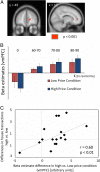The medial prefrontal cortex exhibits money illusion
- PMID: 19307555
- PMCID: PMC2664018
- DOI: 10.1073/pnas.0901490106
The medial prefrontal cortex exhibits money illusion
Abstract
Behavioral economists have proposed that money illusion, which is a deviation from rationality in which individuals engage in nominal evaluation, can explain a wide range of important economic and social phenomena. This proposition stands in sharp contrast to the standard economic assumption of rationality that requires individuals to judge the value of money only on the basis of the bundle of goods that it can buy-its real value-and not on the basis of the actual amount of currency-its nominal value. We used fMRI to investigate whether the brain's reward circuitry exhibits money illusion. Subjects received prizes in 2 different experimental conditions that were identical in real economic terms, but differed in nominal terms. Thus, in the absence of money illusion there should be no differences in activation in reward-related brain areas. In contrast, we found that areas of the ventromedial prefrontal cortex (vmPFC), which have been previously associated with the processing of anticipatory and experienced rewards, and the valuation of goods, exhibited money illusion. We also found that the amount of money illusion exhibited by the vmPFC was correlated with the amount of money illusion exhibited in the evaluation of economic transactions.
Conflict of interest statement
The authors declare no conflict of interest.
Figures


Similar articles
-
Common and distinct neural substrates of the money illusion in win and loss domains.Neuroimage. 2019 Jan 1;184:109-118. doi: 10.1016/j.neuroimage.2018.09.032. Epub 2018 Sep 13. Neuroimage. 2019. PMID: 30219291
-
Overlapping responses for the expectation of juice and money rewards in human ventromedial prefrontal cortex.Cereb Cortex. 2011 Apr;21(4):769-76. doi: 10.1093/cercor/bhq145. Epub 2010 Aug 23. Cereb Cortex. 2011. PMID: 20732900
-
Distinct value signals in anterior and posterior ventromedial prefrontal cortex.J Neurosci. 2010 Feb 17;30(7):2490-5. doi: 10.1523/JNEUROSCI.3319-09.2010. J Neurosci. 2010. PMID: 20164333 Free PMC article. Clinical Trial.
-
How reinforcer type affects choice in economic games.Behav Processes. 2007 Jun;75(2):107-14. doi: 10.1016/j.beproc.2007.02.001. Epub 2007 Feb 8. Behav Processes. 2007. PMID: 17353099 Review.
-
Social, self, (situational), and affective processes in medial prefrontal cortex (MPFC): Causal, multivariate, and reverse inference evidence.Neurosci Biobehav Rev. 2019 Apr;99:311-328. doi: 10.1016/j.neubiorev.2018.12.021. Epub 2019 Jan 2. Neurosci Biobehav Rev. 2019. PMID: 30610911 Review.
Cited by
-
Neural correlates of time versus money in product evaluation.Front Psychol. 2012 Oct 1;3:372. doi: 10.3389/fpsyg.2012.00372. eCollection 2012. Front Psychol. 2012. PMID: 23162485 Free PMC article.
-
A nickel ain't worth a dime anymore: the illusion of money and the rapid encoding of its true value.PLoS One. 2013;8(1):e55025. doi: 10.1371/journal.pone.0055025. Epub 2013 Jan 30. PLoS One. 2013. PMID: 23383044 Free PMC article.
-
Ventromedial prefrontal cortex response to concentrated sucrose reflects liking rather than sweet quality coding.Chem Senses. 2013 Sep;38(7):585-94. doi: 10.1093/chemse/bjt029. Epub 2013 Jul 4. Chem Senses. 2013. PMID: 23828907 Free PMC article.
-
Neural correlates of gratitude.Front Psychol. 2015 Sep 30;6:1491. doi: 10.3389/fpsyg.2015.01491. eCollection 2015. Front Psychol. 2015. PMID: 26483740 Free PMC article.
-
In the mind of the market: theory of mind biases value computation during financial bubbles.Neuron. 2013 Sep 18;79(6):1222-31. doi: 10.1016/j.neuron.2013.07.003. Neuron. 2013. PMID: 24050407 Free PMC article.
References
-
- Tyran J-R. Money illusion and the market. Science. 2007;317:1042–1043. - PubMed
-
- Shafir E, Diamond P, Tversky A. Money illusion. Q J Econ. 1997;112:341–374.
-
- Tobin J. Inflation and unemployment. Am Econ Rev. 1972;62:1–18.
-
- Fehr E, Tyran J-R. Does money illusion matter? Am Econ Rev. 2001;91:1239–1262.
-
- Yellen JL, Akerlof GA. Stabilization policy: A reconsideration. Econ Inq. 2006;44:1–22.
Publication types
MeSH terms
LinkOut - more resources
Full Text Sources

